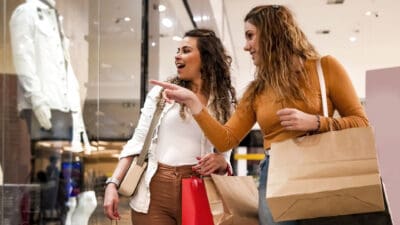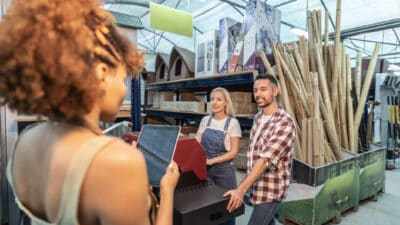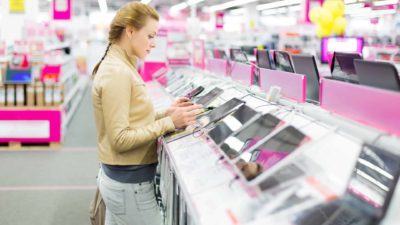2020 has already been a bloodbath for retailers with numerous stores closing down. Closures that started in 2019 have continued into the new year with the loss of Jeanswest, McWilliam's Wines, and Colette by Colette Hayman.
The Christmas shopping season provided no reprieve with sales down 0.5%, highlighting considerable pressure on the Australian retail sector.
Weak consumer demand, ongoing price competition, and rising costs have many retailers struggling to survive. Yet, some are bucking the trend and thriving in the currently harsh retail environment.
With that, here we take a look at three ASX retail shares that are delivering despite the downturn.
Temple & Webster Group Ltd (ASX: TPW)
Temple & Webster shares are up more than 44% since the start of 2020 with the online homewares retailer recently reporting stellar sales figures. Revenue rose 50% in 1H20 to $74.1 million, a huge increase over 1H19 revenue of $49.4 million.
Operating an online-only model, Temple & Webster is a market leader in the homewares and furniture sector with the shift to online shopping a result of demographic changes independent of macroeconomic factors.
With a range of more than 180,000 products, approximately 80% of the retailer's sales do not require it to hold inventory, allowing for significant cost savings.
Temple & Webster's 1H20 results
Temple & Webster reported earnings before interest, tax, depreciation and amortisation (EBITDA) of $2.3 million in 1H20, up from $1 million only a year prior.
The retailer's rapid growth has allowed it to forge closer partnerships with suppliers and accelerate investment in key areas of differentiation such as technology.
Furniture and homewares is a $13.9 billion market, of which only 4 to 5% has moved online. That percentage, however, is growing with Temple & Webster reporting 45% active customer growth. Online penetration in the furniture and homewares category is more than 14% in the US and UK.
Temple & Webster is a profitable business with strong top-line growth and a debt-free balance sheet. Demographic changes will drive strong market growth over the long term as Millenials move into the age range where the bulk of furniture and homewares spending occurs.
Lovisa Holdings Ltd (ASX: LOV)
The Lovisa share price surged yesterday following the release of the accessory and jewellery retailer's half-year results. In the first hour of trade, shares were up more than 10%, peaking at $11.75 before dropping back to $11.30 by market close. Lovisa reported $162 million in revenue, a 22% increase over 1HFY19.
Recent 1H20 results
Lovisa opened a net 49 new stores during the half-year, continuing its global rollout strategy. eCommerce is now live in Australia, New Zealand, UK/EU, and Asia, with comparable-store sales up 2.1% for the half-year. Price increases implemented to offset adverse currency impacts on margin had minimal impact on comparable store sales.
The retailer reported a 10.7% increase in earnings before interest and tax (EBIT) which reached $40.41 million from $36.49 million in the prior corresponding period (pcp). Net profit after tax increased 9.1% to $27.85 million with earnings per share of 26.3 cents. A fully franked interim dividend of 15 cents per share was declared.
Lovisa has a strong balance sheet available to fund growth. Investment in fit out and inventory for new stores has been funded from existing cash reserves with net cash of $12.6 million at period end. The retailer continues to focus on disciplined inventory management, with increased inventory holding to support the store roll-out profile and franchise store growth.
International store rollout
The international rollout has continued apace with 65% of the store network now located offshore.
Ten new stores were opened in France during the period and four in the UK, with the focus on securing quality sites. Stores are now open in 8 US states with Lovisa viewing the US as a significant long term opportunity.
The company continues to invest in structures to support this but will not sacrifice store quality for speed or size of rollout.
Coronavirus concerns
Trading in January was comparable to the first half with comparable store sales up 2.1%. The publicity around the coronavirus outbreak has, however, impacted store traffic, particularly in Singapore and Malaysia.
As a fast-fashion business Lovisa relies on its China-based supply chain to ensure stock availability. The coronavirus has resulted in delays in the warehouse that replenishes the Northern Hemisphere and South African markets.
Delays have also been experienced in manufacture however this is now ramping back up to full production and the warehouse is returning to full capacity.
Accent Group Ltd (ASX: AX1)
Accent Group shares have surged 14% this month to yesterday's closing price of $1.94. The footwear retailer reported its half-year results after market close yesterday with net profit after tax (NPAT) jumping 9.7%.
Accent Group is Australia's largest footwear retailer with about a 20% share of the market. The Group operates across multiple retail banners with distribution rights for 10 international brands in Australia and New Zealand. Brands include The Athlete's Foot, Hype DC, Sketchers, CAT, Saucony, Vans, Dr Martens and Timberland.
Strong sales growth
Accent Group's sales increased 10.9% to $507 million in the first half. EBITDA of $67.7 million for 1H20 was reported, up 10.5% from 1H19. An interim dividend of 5.25 cents was declared, up 16.7% from 4.50 cents in the pcp.
The group opened 51 new stores in 1H20 and now boasts a network of more than 500 stores. During the half, Accent Group launched Shubar in Hype, The Trybe accessories, TAF performance socks, Alpha school shoes and new accessory ranges in Platypus and Hype. Additionally, digital sales growth of 33% was reported.
FY20 outlook
In FY20, Accent Group plans to open at least 70 new stores, with a further 30 to 40 stores planned by FY22 across Platypus, Hype, Sketchers, CAT, Dr Martens, Merrell, TAF and Vans.
The group is undertaking ongoing investment to scale infrastructure and support digital growth, targeting 20% of digital sales within the next 3 years.
The group continues to focus on cost of doing business improvements, noting gross margin pressure from foreign exchange movements and the competitive environment.
In the first 7 weeks of 2H20, like-for-like retail sales were up 3% on the same period last year. Profit growth in the second half will be delivered through low single-digit like-for-like growth and strong digital growth, along with growth from new stores.








